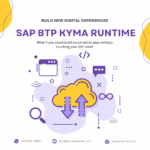Introduction
In today’s fast-paced business environment, off-the-shelf solutions often fall short of meeting unique enterprise needs. While standard SAP modules deliver robust functionality, the real competitive edge comes from tailoring these systems to fit your organization’s specific processes. This is where SAP ABAP (Advanced Business Application Programming) steps in. Not just a programming language, SAP ABAP is the cornerstone for building custom solutions that enhance and extend the capabilities of your SAP environment.
This blog explores the strategic importance of SAP ABAP, its role in unlocking custom innovation, and how organizations can harness its power to create a more agile, responsive, and data-driven enterprise.
The Why: The Need for Customization
In every modern organization, no two businesses are exactly alike. Companies vary in size, structure, and market demands. While standard SAP modules provide a strong foundation, they are designed for general use. The gap between standard functionality and unique business requirements often calls for customization.
The Case for SAP ABAP
- Unique Business Processes: Every enterprise has its own workflows and procedures that require tailor-made solutions. SAP ABAP allows you to build custom reports, interfaces, and transactions that align perfectly with your operations.
- Enhanced User Experience: Custom interfaces and tailored applications can dramatically improve user adoption and satisfaction, ensuring that the system truly works for its users.
- Competitive Advantage: Organizations that adapt their systems to their specific needs are better positioned to react to market changes, optimize performance, and outperform competitors.
- Scalability and Flexibility: As your business evolves, so do your processes. SAP ABAP provides the flexibility to extend and modify your SAP environment without overhauling the entire system.
In essence, SAP ABAP isn’t just about coding—it’s about creating a foundation that drives strategic business value.
The Problem: Limitations of Standard ERP Systems
Despite the sophistication of modern ERP systems, standard solutions often leave gaps:
Data Silos and Inconsistent Reporting
Many enterprises struggle with data scattered across various modules. Without customization, reports can be generic, forcing decision-makers to piece together information from different sources. This fragmentation leads to inconsistent insights and can hinder strategic planning.
Inflexible Business Processes
Standardized processes are built to serve the majority, but they often don’t account for the nuances of your business. As a result, manual workarounds and inefficient processes become common—draining time and resources, and stifling innovation.
Slow Adaptation to Change
When market conditions shift or new business opportunities arise, off-the-shelf ERP systems can be slow to adapt. Custom solutions built with SAP ABAP empower organizations to respond swiftly by modifying or extending their systems without lengthy overhauls.
Increased Operational Costs
Inefficient, manual processes not only lead to errors but also increase operational costs. The time and resources spent on workaround solutions could be better allocated toward strategic initiatives. By addressing these inefficiencies with custom SAP ABAP programs, organizations can significantly reduce waste and improve profitability.
The How: Leveraging SAP ABAP for Tailored Innovation
SAP ABAP offers a powerful set of tools that allow organizations to bridge the gap between standard ERP functionalities and bespoke business requirements. Here’s how:
Custom Report Development
One of the most common applications of SAP ABAP is in developing custom reports. Standard reports can be limited in scope and flexibility. With SAP ABAP, you can create reports that:
- Integrate data from multiple modules seamlessly.
- Provide real-time, drill-down insights tailored to specific business needs.
- Offer interactive dashboards that support decision-making processes.
By tailoring reporting tools, companies can ensure that every decision is based on comprehensive, accurate, and relevant data.
Building Custom Interfaces
User experience is critical. Custom interfaces built with SAP ABAP can simplify complex processes and present data in an intuitive way. For example:
- Role-Specific Dashboards: Create dashboards that display only the information relevant to a user’s role, reducing clutter and increasing efficiency.
- Mobile-Optimized Applications: Develop applications that allow users to access critical data on-the-go, ensuring that decision-makers have real-time insights regardless of their location.
- Enhanced Data Entry Forms: Design user-friendly forms that minimize errors and speed up data entry, improving the overall quality of the information captured.
Integration and Interfacing
Today’s businesses often run a mix of SAP and non-SAP systems. SAP ABAP is instrumental in building custom interfaces that enable seamless data exchange between these systems. This includes:
- Middleware Solutions: Creating interfaces that connect SAP with external applications, databases, or legacy systems.
- API Development: Building and managing APIs to expose SAP functionalities securely, allowing other systems to interact with SAP data in real time.
- Data Migration Tools: Developing custom solutions to facilitate data migration during system upgrades or consolidations, ensuring data integrity throughout the process.
Enhancing Process Automation
Manual interventions in business processes can lead to errors and inefficiencies. SAP ABAP empowers organizations to automate these processes by:
- Automating Repetitive Tasks: Writing custom programs to automate routine tasks such as invoice processing, order fulfillment, and inventory updates.
- Streamlining Workflow: Integrating SAP ABAP with workflow tools to create automated, end-to-end processes that reduce the need for manual intervention.
- Dynamic Process Adjustments: Developing solutions that adjust workflows dynamically based on real-time data and business conditions, enabling more responsive operations.
Improving System Performance and Scalability
As your business grows, so do the demands on your SAP system. SAP ABAP allows you to optimize performance by:
- Optimizing Code: Custom ABAP programs can be fine-tuned to run efficiently, reducing system load and speeding up processing times.
- Scalable Solutions: Building scalable applications that can handle increasing volumes of data without compromising performance.
- Proactive Monitoring: Developing tools that monitor system performance in real time, alerting administrators to potential issues before they impact operations.
Real-World Impact: SAP ABAP Success Stories
Case Study 1: A Global Consumer Goods Company
A multinational consumer goods company faced challenges with inconsistent reporting across its diverse product lines. By leveraging SAP ABAP, the company developed custom dashboards that consolidated data from multiple regions into a single, cohesive report. This transformation led to a 35% reduction in report generation time and provided executives with real-time insights into product performance—enabling faster, more informed decision-making.
Case Study 2: Enhancing User Experience in Manufacturing
A large manufacturing firm struggled with complex data entry processes that resulted in frequent errors and delays. Using SAP ABAP, the IT team developed a custom interface for production data entry. The new interface streamlined the process, reduced errors by 40%, and significantly improved data accuracy, ultimately leading to better production planning and reduced downtime.
Case Study 3: Seamless Integration in Financial Services
A leading financial institution needed to integrate its legacy systems with its modern SAP environment. Custom SAP ABAP interfaces were developed to enable real-time data exchange, bridging the gap between old and new systems. This integration not only improved data consistency but also enhanced the speed and reliability of financial reporting—resulting in a more agile and responsive organization.
Best Practices for SAP ABAP Development
To maximize the benefits of SAP ABAP, consider these best practices:
1. Start with Clear Objectives
Define what you aim to achieve with your custom development. Identify key pain points, set measurable goals, and align your projects with broader business objectives. This clarity ensures that every custom solution delivers real value.
2. Engage Stakeholders Early
Involve end-users, department heads, and IT experts from the beginning. Their input is critical in designing solutions that truly address real-world challenges and integrate seamlessly with existing processes.
3. Prioritize Standard Functionality
Before developing custom solutions, explore the standard functionalities available in SAP. Use custom ABAP programming only when necessary to fill gaps or enhance specific processes. This approach minimizes complexity and eases future system upgrades.
4. Focus on User Experience
Even the most powerful tool is useless if it isn’t user-friendly. Invest time in designing intuitive interfaces and workflows. Regularly gather user feedback and make iterative improvements to ensure that the system meets their needs.
5. Maintain Clean, Efficient Code
Good coding practices are essential. Write clear, well-documented code and regularly review and optimize your programs to ensure they run efficiently. This not only improves system performance but also makes maintenance easier.
6. Test Rigorously
Before deploying custom solutions, conduct thorough testing across different scenarios to identify and fix potential issues. Continuous monitoring and regular updates are crucial for maintaining system stability and performance.
Conclusion
SAP ABAP is more than just a programming language—it’s a strategic tool that enables organizations to tailor their SAP environment to meet unique business challenges. By developing custom solutions that enhance reporting, streamline processes, and integrate disparate systems, companies can achieve a more agile, efficient, and competitive operation.
The future of enterprise success lies in the ability to adapt quickly, leverage real-time data, and build systems that truly serve the needs of the business. SAP ABAP offers the flexibility and power to do just that—empowering organizations to turn challenges into opportunities and drive sustainable growth.
As you navigate the evolving landscape of digital transformation, consider how a tailored approach with SAP ABAP can elevate your operations. The path to a more intelligent and responsive enterprise starts with the right custom solutions, built to align perfectly with your business vision.
Are you ready to redefine your SAP environment? With SAP ABAP, the power to innovate is in your hands.











